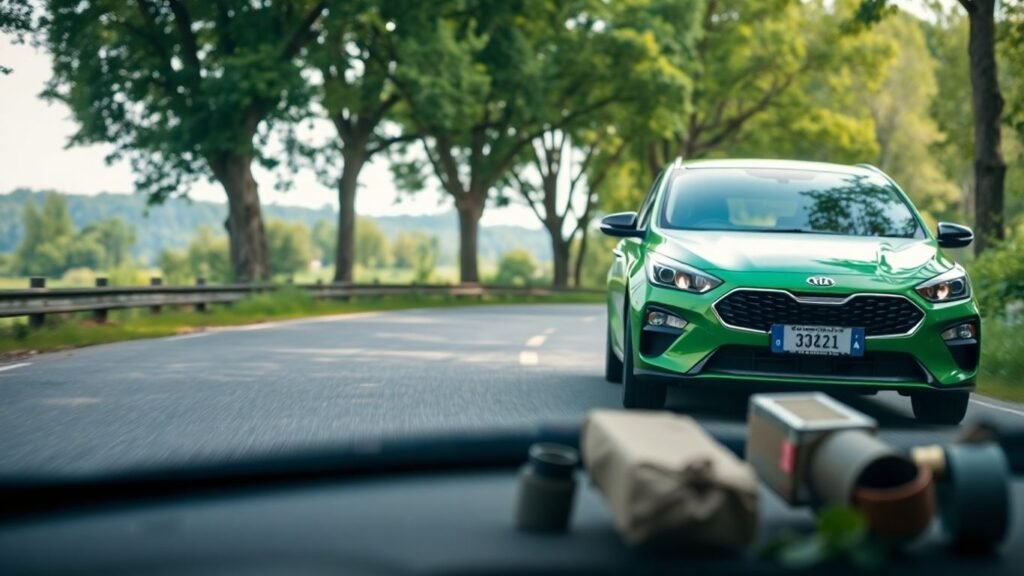When you think about making your car greener, you might picture buying a new electric vehicle or switching to a hybrid. But there’s another way to help the planet—using recycled parts for your Kia. More drivers are realizing that the eco-friendly benefits of using Kia recycled parts go beyond just saving money. These parts help reduce waste, cut down on pollution, and support a cleaner future without sacrificing the quality you expect from your car. Let’s break down how choosing recycled Kia parts can make your drive a little greener and a lot smarter.
Key Takeaways
- Kia recycled parts help keep old car materials out of landfills and support a circular economy.
- Using recycled parts cuts down on the energy and pollution that comes from making new parts from scratch.
- Kia’s green manufacturing includes renewable energy and sustainable materials, making the whole process cleaner.
- Recycled parts can save you money and sometimes even qualify for government incentives or rebates.
- Choosing recycled Kia parts means you’re supporting global and local efforts to protect the environment, all while keeping your car reliable.
Understanding the Eco-Friendly Benefits of Using Kia Recycled Parts
Reducing Landfill Waste and Supporting Circular Economy
When I swapped out my old Kia headlamp for a recycled part, it struck me how many car parts out there just end up dumped. Instead of tossing these old components into a landfill, recycling gives them a second shot at life. Kia’s approach means fewer parts waste away in junkyards and more materials circulate back into our hands, keeping that loop going. That’s the basis of a circular economy—reuse what we’ve already got instead of always making things from scratch.
With every recycled part used, there’s less pressure on landfills and a push toward using what already exists in smarter, more responsible ways.
Lowering Production Emissions Through Recycling
The difference in emissions between creating a new Kia part and refurbishing an old one can be surprising. Building something from the ground up requires extracting raw materials, smelting, and shaping them, which burns a lot of energy and spits out plenty of greenhouse gases. In comparison, the process for recycled parts is much lighter on emissions, since you’re skipping most of those big energy steps.
| Production Stage | New Part (CO₂, kg) | Recycled Part (CO₂, kg) |
|---|---|---|
| Raw Material Extraction | 6.0 | 0.8 |
| Manufacturing | 4.5 | 1.2 |
| Distribution | 2.0 | 1.5 |
| Total | 12.5 | 3.5 |
Message is pretty clear (at least to me): using recycled parts really helps slash a car’s overall manufacturing carbon footprint.
Decreasing the Demand for New Raw Materials
Every fresh Kia part pulled straight from the assembly line puts another strain on natural resources. Metals need to be mined, plastics come from oil, and all that work hammers the environment. But with recycled parts, you’re not just skipping steps; you’re making sure existing materials last as long as possible. This cuts down the need to dig up or process even more new stuff, keeping the earth a little less disturbed.
Relying more on recycled components means less mining, fewer emissions, and a healthier planet. That’s a win for any Kia owner who cares about what happens beyond their driveway.
How Kia’s Sustainable Manufacturing Strengthens Green Driving
Utilizing Renewable Energy in Production Facilities
Kia has swapped a big chunk of its old energy mix for greener sources, with more and more factories running on solar, wind, and even hydroelectric power. These cleaner energy options are showing up in real ways, like lower emissions at Kia’s plants. It might sound a bit technical, but it basically means the cars rolling out use less polluting energy from the very start. In fact, over 80% of Kia’s global manufacturing now draws power from renewable energy—that’s a shift you can really get behind as someone thinking about your next vehicle.
| Factory Region | Percentage Powered by Renewables |
|---|---|
| Global (Average) | 80% |
| Hwaseong, South Korea | 100% |
The transition to renewable energy in car manufacturing gives drivers simple peace of mind, knowing the vehicle was built without as much fossil fuel reliance.
Commitment to Carbon Neutrality Goals
Kia has made a public promise to hit carbon neutrality by 2045. This goal is more than just a talking point—it means updates to everything from how they source materials, all the way to how the final product is delivered. This shift covers stamping out waste, using more recycled materials, and setting emissions limits. Many buyers these days want to know if their car’s brand takes responsibility, and for Kia, it’s a work in progress with real dates and targets. They’re pushing for carbon cuts across the board, not just in one facility or model.
Sourcing Sustainable Materials for Vehicle Construction
Instead of acting like the material supply is endless, Kia takes steps to use recycled and renewable stuff when building their vehicles. You’ll see eco-friendly plastics, reused metals, and even things like seat covers made from recycled bottles. There’s a push to get at least a fifth of all plastic components in their cars to come from recycled sources by 2030. That’s not an empty promise—some of Kia’s newest models already use vegan leather and other non-traditional materials. The result is a car that looks and feels good, but is a lot less wasteful right from the factory floor.
Enhanced Vehicle Performance with Recycled Kia Parts
Maintaining Reliability and Safety Standards
Recycled Kia parts aren’t just about being green—they’re built with the same careful process as new components. Every recycled piece gets tested for safety and durability, so it lines up with Kia’s standards. Drivers shouldn’t have to trade safety or reliability for sustainability. You get the same peace of mind behind the wheel, whether you’re cruising to work or making a long trip to see family.
Getting a reliable drive doesn’t have to mean buying brand-new parts every time. Lots of people are surprised by how much recycled components can hold up in everyday use—each one goes through a bunch of checks before reaching you.
Preserving High-Quality Driving Experiences
Stepping on the gas, turning the wheel, or just rolling down the windows—those moments feel the same whether your car’s built with new or recycled parts. The materials Kia recycles keep their shape and function, letting drivers enjoy quiet, smooth rides, responsive controls, and all the little things that make the Kia driving experience special.
| Feature | New OEM Parts | Certified Recycled Parts |
|---|---|---|
| Safety Tested | Yes | Yes |
| Warranty Available | Yes | Yes |
| Performance Standards | Yes | Yes |
| Environmental Impact | Higher | Lower |
Ensuring Long-Lasting Components for Kia Vehicles
A lot of people worry that recycled parts might give out sooner, but that’s not the case if you choose certified ones for your Kia. These parts are carefully taken from vehicles that have reached the end of their life, cleaned, and tested. This way, engines, transmissions, and even interior bits get a second chance—and they often last just as long as new. When you choose certified recycled parts, you’re making a solid investment in your car’s future without adding to waste.
Cost Advantages of Choosing Kia Recycled Parts for Your Vehicle
Saving Money Compared to New OEM Parts
Going for Kia recycled parts almost always means spending less than if you bought brand-new OEM parts. The process of reclaiming and preparing used parts skips a lot of the manufacturing costs tied up in brand new parts. This price difference can be pretty noticeable, especially with larger components or when dealing with older vehicles where new OEM parts may carry a hefty premium.
| Part Type | New OEM Price | Typical Recycled Price |
|---|---|---|
| Bumper | $800 | $350 |
| Headlight Assembly | $400 | $120 |
| Alloy Wheel | $600 | $180 |
| Side Mirror | $300 | $90 |
Stretching your maintenance budget further makes ownership feel a bit lighter on your wallet, especially when you factor in those unexpected repairs that seem to come out of nowhere every couple of years.
Accessing Government Incentives and Rebates
You might not expect this, but using recycled car parts can sometimes qualify you for tax rebates or local eco-initiatives, depending on where you live. As governments try to steer more drivers toward greener choices, some cities and states offer perks like reduced disposal fees or tax credits for repairs made with recycled parts. These programs aren’t everywhere yet, but it’s worth checking because they directly lower what you pay out of pocket on repairs or upgrades.
Contributing to More Affordable Repairs and Upgrades
There’s also a practical upside: when repair shops can source quality recycled Kia parts, they keep repair costs competitive for everyone. That means more drivers can afford repairs, instead of postponing maintenance or skipping it altogether, which often leads to bigger headaches (and bills) down the road. Your car stays on the road, and your bank account doesn’t take such a hard hit. It’s a pretty good deal, honestly.
Supporting Community and Global Green Initiatives Through Kia’s Recycling Programs
Participation in Environmental Partnerships Like The Ocean Cleanup
Working with organizations like The Ocean Cleanup, Kia has gone beyond simply building greener cars. They actually pitch in to clean up the planet — funding major ocean waste removal projects and contributing their logistical know-how. This partnership supports technologies that prevent plastic from ever making it to the ocean and helps scoop out waste already in our waterways. Kia’s involvement isn’t just a public relations move; it’s hands-on, boots-on-the-ground stuff, directly backing efforts to slow environmental damage at a large scale.
It’s clear that when a major company like Kia links up with nonprofit partners, the impact can go far beyond recycling individual car parts. These actions ripple outwards, helping protect local ecosystems and boost public interest in environmental action for years ahead.
Promoting Awareness of Responsible Auto Recycling
Kia takes extra steps to get the word out about recycling vehicles and parts the right way. They explain not just why you should recycle, but how to do it responsibly so materials actually get used again and don’t just end up as waste. You’ll find Kia supporting recycling drives and public education campaigns, talking about the benefits for local communities and the entire auto industry.
One small but telling thing: Kia even encourages its dealerships, mechanics, and drivers to choose certified recycled parts, so everyone learns just how much of a difference that can make — not only for the environment but for daily driving, too.
Encouraging Sustainable Choices Among Kia Owners
The company knows that big initiatives only matter if people follow through on a daily basis. That’s why Kia inspires owners to think greener — whether it’s picking recycled replacement parts, maintaining their cars for optimal lifespan, or recycling their vehicles at the end. Over time, these choices rack up real benefits for both local communities and the planet.
| Initiative | Impact Example | Who Benefits |
|---|---|---|
| Ocean Cleanup Partnership | Oceans and local waterways | Global communities |
| Education on Responsible Auto Recycling | Less landfill waste, more reuse | Local recyclers, owners |
| Incentives for Using Recycled Parts | Lower repair costs, less demand | Kia drivers, environment |
In the end, all these moves support a shift toward sustainability that’s about much more than just cars. It’s about building a network where people, companies, and nonprofits all pull together for a cleaner, greener future.
Kia Recycled Parts and the Advancement of Electric Vehicle Sustainability

Boosting the Circular Economy for EV Components
Using recycled Kia parts in electric vehicles (EVs) actually makes the EV market cleaner, not just in theory but in practice. The cool thing about it is that whenever someone chooses a recycled part, it keeps older components in the system rather than sending them to the landfill. This makes sure fewer new materials are needed, which disrupts the non-stop cycle of mining, refining, and manufacturing. It’s a real step toward a closed-loop circular economy, especially for high-value EV parts like motors, inverters, and battery packs. Here’s a look at how much material recycling impacts the EV market:
| Component | Typical Recycling Rate (%) |
|---|---|
| High-voltage Batteries | 80-90 |
| Electric Motors | 70-80 |
| Aluminum Body Panels | 90 |
| Plastics & Interior Parts | 20-30 |
Even choosing one recycled part over new can save energy, cut emissions, and help shrink the growing pile of junked auto parts—small changes that, multiplied, really do affect the whole market.
Recycling and Reusing EV Batteries Effectively
Kia has put real focus on collecting, recycling, and reusing batteries from its electric vehicles. Rather than letting batteries become hazardous waste, many useful materials like lithium, nickel, and cobalt are extracted for new battery production or for second-life uses such as stationary storage. This takes some of the pressure off raw material mining. Batteries that still hold a charge can be refurbished for use in backup power grids or solar systems, directly supporting renewable energy efforts. Kia’s battery recycling aims to recover up to 90% of valuable battery materials; that’s a lot less environmental mess versus old-fashioned dumping.
Aligning With a Broader Shift Toward Clean Transportation
Recycled Kia parts are a natural fit in the global movement toward a cleaner car culture. EVs already cut tailpipe pollution, but the manufacturing side also matters. Using recycled and reclaimed materials makes the entire EV lifecycle less wasteful. Kia’s recycled parts help position the brand as one of the automakers actually walking the walk in sustainable transport. More than just a marketing phrase, recycled content puts cleaner mobility within reach for more people, not just in big cities but anywhere drivers care about their impact on the world.
Practical Steps for Drivers to Embrace Eco-Friendly Benefits of Using Kia Recycled Parts

Identifying Certified Recycled Kia Parts
Finding the right recycled parts for your Kia often takes a little more patience than just heading to the dealership. The key is making sure the parts are certified and up to the standards set by Kia, so you’re not left second-guessing what’s under your hood. Look for labels, certifications, or guarantees that the part has been inspected and approved as usable for your specific Kia model. The parts might come from Kia’s own recycling program or from a trusted third party that follows manufacturer standards. Don’t forget, if the price seems too good to be true, it probably is. Make sure the seller can show, in writing, that the part has been checked out by a professional.
Sometimes, it takes a few extra calls or emails to find a reliable vendor, but in the end, knowing your car’s parts meet proper safety and eco criteria is worth it.
Working with Eco-Conscious Service Providers
A garage that advertises green practices isn’t enough—they should know how to source, install, and dispose of parts responsibly. Not every auto shop wants to deal with recycled parts, but some have made it their thing. Ask about their supplier network and how they handle old parts. It can be as simple as texting a few friends for recommendations. You’ll probably find that a shop with a strong eco reputation is also a place where mechanics actually explain things to you in plain English.
The right shop makes the whole process smoother, and you’ll leave knowing your car—and the planet—are in good hands.
Educating Yourself on Sustainable Auto Care Options
Sustainable car care doesn’t stop after picking a recycled part—maintenance matters too. Educate yourself just enough to ask the right questions: what materials are used in repairs, where do discarded parts go, and how often does your Kia actually need replacement pieces instead of repairs? With a bit of research, you start to see the connection between smart maintenance and a smaller footprint. Even simple changes, like using recycled oil or eco-friendly cleaning products, make a difference if you stick with them.
| Option | Impact | Typical Cost Savings |
|---|---|---|
| Recycled brake pads | Reduces landfill waste | 10–20% |
| Used OEM body panels | Saves raw materials | 20–40% |
| Re-manufactured alternators | Lowers emissions | 25–35% |
Once you start looking at the bigger picture, those little choices add up to something pretty impactful for both your wallet and the environment.
Conclusion
Switching to Kia recycled parts is a pretty simple way to make your drive a bit greener. It’s not just about saving a few bucks—though that’s a nice bonus—but it’s also about cutting down on waste and giving old materials a second life. Every time you pick a recycled part, you’re helping the environment, even if it doesn’t feel like a huge step. Plus, Kia’s focus on sustainability means you can trust the quality is still there. So, whether you’re fixing up your car or just thinking about your next upgrade, choosing recycled parts is an easy win for both your wallet and the planet. It’s a small change, but if enough of us do it, it really adds up.








